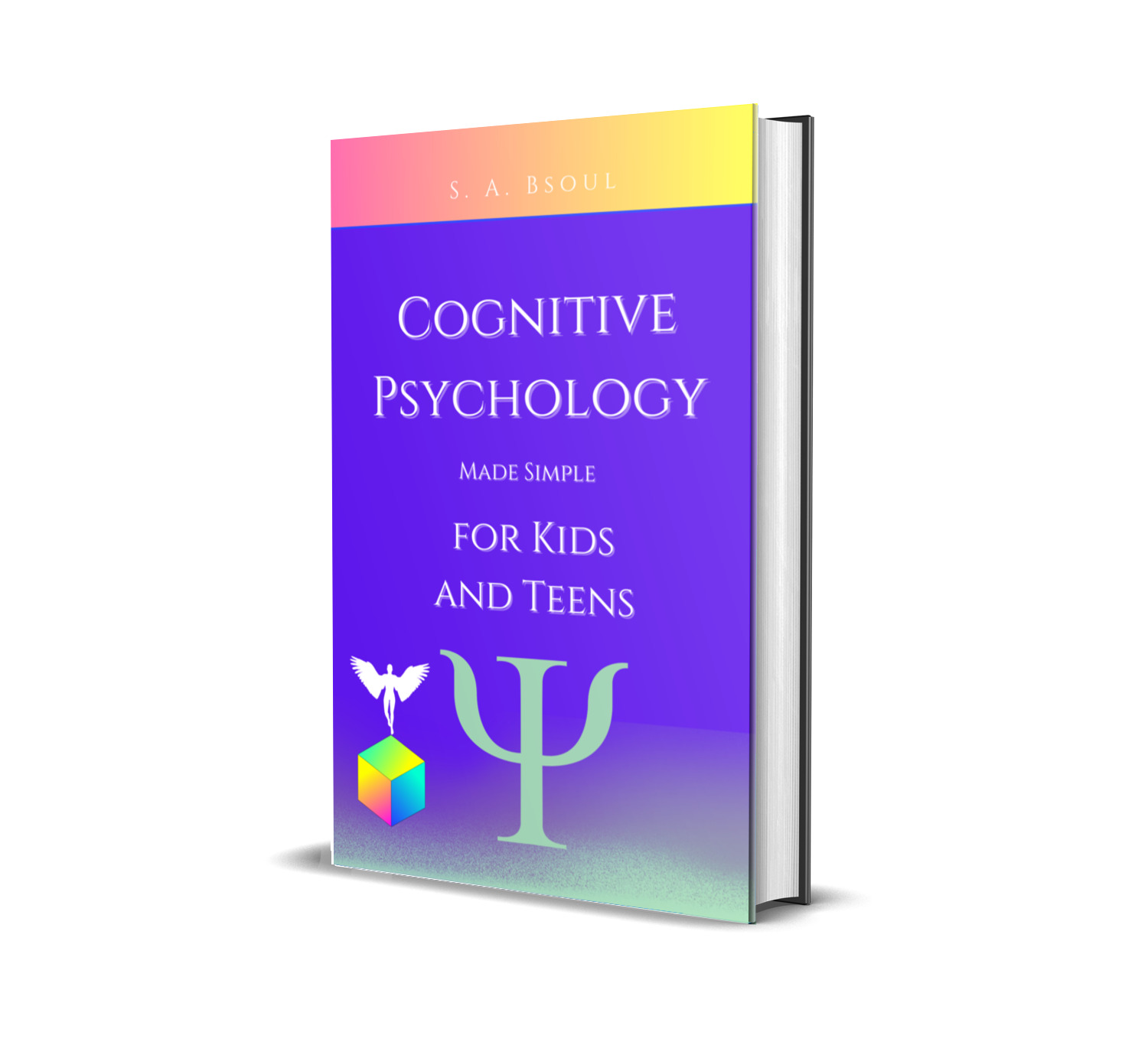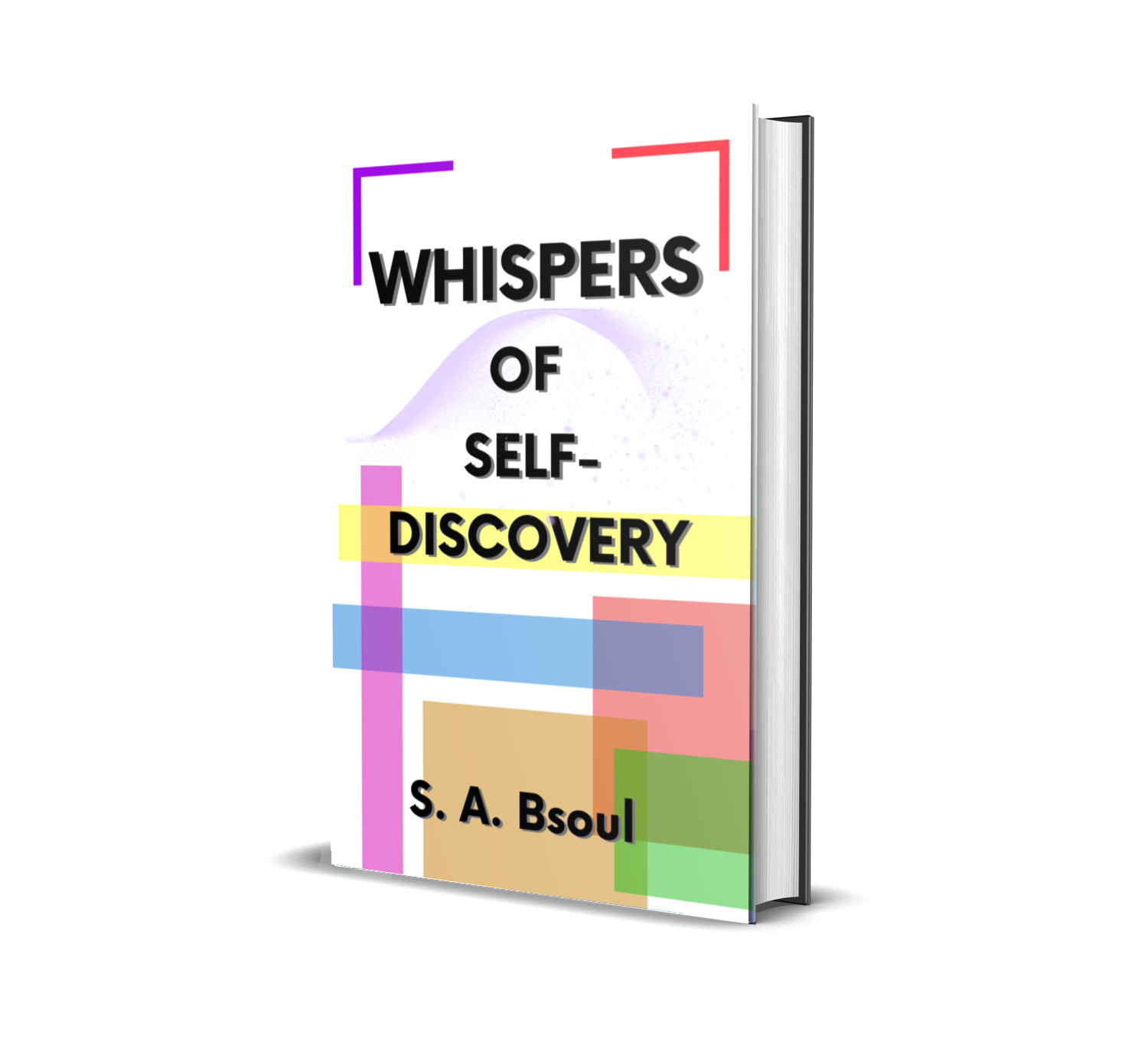Insights into Clinical Psychology: Mindscapes
Sami Bsoul, PhD
My purpose of writing this book is to give people the opportunity to get some insights about clinical psychology like never been offered before.
The book is full of knowledge about the fascinating world of clinical psychology. It covers almost everything you need to know about the field, including examples of researches and findings.

In some chapters, I went more into a deep look into the heart of clinical psychology, in some chapters I went into the depths of the human experiences. Particularly, I focused on trauma and resilience, and I tried to explore the complexities of the human mind and examine how experiences of trauma can deeply affect us.

Additionally, the book provides a detailed look at how psychological distress interacts with our inner resilience.
Understanding the human mind is not just about knowledge; it is about unlocking the secrets to a more fulfilling life. You can learn amazing things and how strong you are. You will understand how people think and feel. You might find out more about yourself.

As I peel back the layers of clinical psychology to reveal its core principles and practices, the book starts with in-depth look at the basic concepts of clinical psychology.
At the very first pages, I defined what clinical psychology is, then I traced its origins over time, taking in mind emphasizing the crucial role that clinical psychologists play in supporting our mental health and our well-being.

I also looked into the neurobiological basis of trauma and resilience. Exploring how the brain, emotions, and stress response systems interact, I also discussed different psychological theories about trauma, and I uncovered, as much as I could, how people think, behave, and feel in response to difficult situations.
The book provides readers with practical tools to assess and diagnose trauma. Guiding them through the complexities of evaluating trauma and considering cultural factors in diagnosis, it also discusses evidence-based treatments for trauma. The book will examine as well the effectiveness of therapies like cognitive-behavioural therapy and eye movement desensitization and reprocessing.

I have tried to uncover the key to resilience and as well I discussed the protective factors and coping strategies. These empower us to navigate the adversity with strength and grace. Then, I explained how to apply trauma-informed care in clinical settings and outlined the principles for creating safe and supportive environments for trauma survivors.
If I want to describe the book in one sentence, I would say it is like learning a secret handshake of emotional resilience, so once you have mastered the art of bouncing back from life's unexpected hurdles, I doubt there will be any challenge too big for you, or any obstacle too daunting. You could say, bring it on, world!

At the very start of the book, I have compiled all the terms used within its pages. Here, you will find a handy dictionary explaining these psychological terms. I believe it will be helpful to become familiar with at least a minimum of what I discussed in the book. Think of it as your own personal glossary of psychological jargon and further on, you do not need to worry about getting lost in a sea of unfamiliar terms.
I explored trauma across diverse populations and examined the unique challenges faced by children, adolescents, veterans, and survivors of interpersonal violence. I navigated the ethical and the cultural considerations in trauma treatment, as well as I addressed the ethical dilemmas and cultural competencies essential for providing effective care.

Looking ahead in the book, I wrote about the possible future of trauma research and practice. It is not an act to envisioning emerging trends, but I tried to highlight advancements that might shape the landscape of clinical psychology in the future.
Of course, I did not use any crystal ball to look into the future of mental health and I did not use any tarot cards, I only studied the cutting-edge research and ground breaking discoveries that might revolutionize the way we think about trauma. Well, no one of us know how much the future will be exciting, but let us hope it will be peaceful.

Bsoul, S. (2024). Insights into Clinical Psychology: Mindscapes [Kindle Edition].
The list of references used in writing this book:
Addis, M. E., & Mahalik, J. R. (2003). Men, masculinity, and the contexts of help seeking. American Psychologist, 58 (1), 5–14.
Ainsworth, M. D. S., Blehar, M. C., Waters, E., & Wall, S. (1978). Patterns of attachment: A psychological study of the Strange Situation. Erlbaum.
Almli, L. M., Fani, N., Smith, A. K., Ressler, K. J., & Koenen, K. C. (2014). Genetic Approaches to Understanding Post-Traumatic Stress Disorder. Depression and Anxiety, 31 (4), 257–265.
American Psychological Association. (2017). Clinical practice guideline for the treatment of posttraumatic stress disorder (PTSD) in adults. Retrieved from https://www.apa.org/ptsd-guideline
American Psychological Association. (2017). Ethical principles of psychologists and code of conduct. Retrieved from https://www.apa.org/ethics/code
American Psychological Association. (2019). Culturally competent care. Retrieved from https://www.apa.org/topics/culturally-competent-care
American Psychological Association. (2019). What is Clinical Psychology? Retrieved from https://www.apa.org/ed/graduate/specialize/clinical
American Psychological Association. (2020). Trauma-Informed Practice: Improving Treatment and Services for Children and Adults. Retrieved from https://www.apa.org/topics/trauma-informed-care
American Psychiatric Association. (2013). Diagnostic and statistical manual of mental disorders (5th ed.). https://doi.org/10.1176/appi.books.9780890425596
Arnold, L. E., Lofthouse, N., & Hersch, S. (2014). EEG neurofeedback for ADHD: double-blind sham-controlled randomized pilot feasibility trial. Journal of Attention Disorders, 18(4), 343-356.
Baker, S. E., & Edwards, R. (2012). How many qualitative interviews is enough?: Expert voices and early career reflections on sampling and cases in qualitative research. National Centre for Research Methods.
Balsam, K. F., Lehavot, K., Beadnell, B., & Circo, E. (2010). Childhood abuse and mental health indicators among ethnically diverse lesbian, gay, and bisexual adults. Journal of Consulting and Clinical Psychology, 78 (4), 459–468.
Baumeister, D., Akhtar, R., Ciufolini, S., et al. (2016). Childhood trauma and adulthood inflammation: A meta-analysis of peripheral C-reactive protein, interleukin-6 and tumour necrosis factor-α. Molecular Psychiatry, 21, 642–649.
Beck, A. T. (1976). Cognitive therapy and the emotional disorders. International Universities Press.
Beck, A. T., Rush, A. J., Shaw, B. F., & Emery, G. (2004). Cognitive Therapy of Depression. New York: Guilford Press.
Beck, A. T. (2008). The evolution of the cognitive model of depression and its neurobiological correlates. The American Journal of Psychiatry, 165 (8), 969–977.
Beck, J. S. (2009). Cognitive therapy: Basics and beyond. Guilford Press.
Beck, J. S. (2011). Cognitive Behavior Therapy: Basics and Beyond (2nd ed.). Guilford Press.
Blake, D. D., Weathers, F. W., Nagy, L. M., Kaloupek, D. G., Gusman, F. D., Charney, D. S., & Keane, T. M. (1995). The development of a Clinician-Administered PTSD Scale. Journal of Traumatic Stress, 8 (1), 75–90.
Bonanno, G. A. (2004). Loss, trauma, and human resilience: Have we underestimated the human capacity to thrive after extremely aversive events? American Psychologist, 59 (1), 20–28.
Bowlby, J. (1969). Attachment and loss: Vol. 1. Attachment. Basic Books.
Braun, V., & Clarke, V. (2013). Successful qualitative research: A practical guide for beginners. SAGE.
Braun, V., & Clarke, V. (2016). (Mis)conceptualising themes, thematic analysis, and other problems with Fugard and Potts’ (2015) sample-size tool for thematic analysis. International Journal of Social Research Methodology, 19 (6), 739–743.
Brand, B., Classen, C., Lanius, R., et al. (2009). A naturalistic study of dissociative identity disorder patients treated by community clinicians. Psychological Trauma: Theory, Research, Practice, and Policy, 1, 153–171.
Bremner, J. D. (2006). Traumatic stress: Effects on the brain. Dialogues in Clinical Neuroscience, 8 (4), 445–461.
Bremner, J. D., Krystal, J. H., Southwick, S. M., & Charney, D. S. (2005). Neural mechanisms in dissociative amnesia for childhood abuse: Relevance to the current controversy surrounding the "false memory syndrome". The American Journal of Psychiatry, 152 (2), 178–186.
Bremner, J. D., Randall, P., Vermetten, E., Staib, L., Bronen, R. A., Mazure, C., ... & Charney, D. S. (1995). Magnetic resonance imaging-based measurement of hippocampal volume in posttraumatic stress disorder related to childhood physical and sexual abuse—a preliminary report. Biological Psychiatry, 41 (1), 23-32.
Breslau, N., Davis, G. C., & Schultz, L. R. (2003). Posttraumatic stress disorder and the incidence of nicotine, alcohol, and other drug disorders in persons who have experienced trauma. Archives of General Psychiatry, 60 (3), 289–294.
Breslau, N., Peterson, E. L., & Schultz, L. R. (2008). A second look at prior trauma and the posttraumatic stress disorder effects of subsequent trauma: A prospective epidemiological study. Archives of General Psychiatry, 65 (4), 431–437.
Brewin, C. R., Dalgleish, T., & Joseph, S. (1996). A dual representation theory of posttraumatic stress disorder. Psychological Review, 103 (4), 670–686.
Brewin, C. R., Dalgleish, T., & Joseph, S. (2010). Intrusive images in psychological disorders: Characteristics, neural mechanisms, and treatment implications. Psychological Review, 117 (1), 210–232.
Bryant, R. A., Felmingham, K., Kemp, A. H., Barton, M., Peduto, A., & Rennie, C. (2020). Neural networks of information processing in posttraumatic stress disorder: A functional magnetic resonance imaging study. Biological Psychiatry, 58 (2), 111–118.
Bryant-Davis, T., & Ocampo, C. (2005). Racist incident-based trauma. The Counseling Psychologist, 33 (4), 479–500.
Bryant-Davis, T., & Wong, E. C. (2013). Faith to move mountains: Religious coping, spirituality, and interpersonal trauma recovery. American Psychologist, 68 (8), 675–684.
Brice, A., Castillo, L. G., Castro, F. G., & Hughes, D. (2020). Cultural considerations in trauma assessment: Implications for clinical practice. Journal of Traumatic Stress, 20 (3), 155–171.
Bonanno, G. A. (2004). Loss, trauma, and human resilience: Have we underestimated the human capacity to thrive after extremely aversive events? American Psychologist, 59 (1), 20–28.
Bonanno, G. A. (2004). Loss, trauma, and human resilience: Have we underestimated the human capacity to thrive after extremely aversive events? American Psychologist, 59 (1), 20.
Bowlby, J. (1969). Attachment and loss: Vol. 1. Attachment. Basic Books.
Bowlby, J., & Horowitz, L. M. (1991). Attachment styles among young adults: A test of a four-category model. Journal of Personality and Social Psychology, 61 (2), 226–244.
Bowles, T., Scull, J., Hattie, J., Clinton, J., Larkins, G., Cicconi, V., Kumar, D., & Arnup, J. L. (2016). Conducting psychological assessments in schools: Adapting for converging skills and expanding knowledge. Issues in Educational Research, 26 (1), 11–15.
Campbell, R., Goodman-Williams, R., & Javorka, M. (2019). A trauma-informed approach to sexual violence research ethics and open science. Journal of Interpersonal Violence, 34 (23-24), 4765–4793.
Carter, R. T., Lau, M. Y., Johnson, V., & Kirkinis, K. (2017). Racial discrimination and health outcomes among racial/ethnic minorities: A meta-analytic review. Journal of Multicultural Counseling and Development, 45 (4), 232–259.
Cassidy, J., & Shaver, P. R. (Eds.). (1999). Handbook of attachment: Theory, research, and clinical applications. Guilford Press.
Chemtob, C. M., Novaco, R. W., Hamada, R. S., Gross, D. M., & Smith, G. (1997). Anger regulation deficits in combat-related posttraumatic stress disorder. Journal of Traumatic Stress, 10 (1), 17–36. https://doi.org/10.1002/jts.2490100104
Cherestal, S., & Herts, K. L. (2021). Trauma-Focused Treatment for PTSD With Comorbid Psychosis: A Case Report. Journal of Traumatic Stress, 20 (3), 1-5.
Clement, S., Schauman, O., Graham, T., Maggioni, F., Evans-Lacko, S., Bezborodovs, N., Morgan, C., Rüsch, N., Brown, J. S. L., & Thornicroft, G. (2014). What is the impact of mental health-related stigma on help-seeking? A systematic review of quantitative and qualitative studies. doi:10.1017/S0033291714000129
Cloitre, M., Stovall-McClough, K. C., Miranda, R., & Chemtob, C. M. (2009). Therapeutic alliance, negative mood regulation, and treatment outcome in child abuse-related post-traumatic stress disorder. Journal of Consulting and Clinical Psychology, 77 (3), 517–528. https://doi.org/10.1037/a0016227
Cloitre, M., et al. (2006). Trauma Systems Therapy: A Framework for Conceptualizing Trauma in Children and Adolescents. Psychiatric Annals, 36 (6), 390-398.
Coben, R., & Evans, J. R. (2010). Neurofeedback and neuromodulation techniques and applications. Academic Press.
Cohen, J. A., Mannarino, A. P., & Deblinger, E. (2006). Treating trauma and traumatic grief in children and adolescents. Guilford Press.
Coker, A. L., Smith, P. H., Thompson, M. P., McKeown, R. E., Bethea, L., & Davis, K. E. (2002). Social support protects against the negative effects of partner violence on mental health. Journal of Women’s Health & Gender-Based Medicine, 11 (5), 465–476.
Connor, K. M., & Davidson, J. R. (2003). Development of a new resilience scale: The Connor-Davidson Resilience Scale (CD-RISC). Depression and Anxiety, 18 (2), 76-82.
Crenshaw, K. (1991). Mapping the margins: Intersectionality, identity politics, and violence against women of color. Stanford Law Review, 43 (6), 1241–1299.
Critenden, P. M. (1999). Danger and development: The organization of self-protective strategies. Attachment & Human Development.
Curtis, E., Jones, R., Tipene-Leach, D., et al. (2019). Why cultural safety rather than cultural competency is required to achieve health equity: A literature review and recommended definition. International Journal of Equity Health, 18, 174.
Davis, E., Patel, M., & Garcia, S. (2019). Genetic and Epigenetic Markers Associated with Post-Traumatic Stress Disorder Vulnerability: A Case Study Analysis. Journal of Traumatic Stress Disorders & Treatment, 6 (4), 185-198.
Davis, R. S., Thompson, L. M., & Johnson, K. P. (2019). Building resilience in combat veterans: A case study of group therapy interventions. Journal of Traumatic Stress Disorders & Treatment, 12 (3), 78-92.
Diamond, G. M., Diamond, G. S., & Levy, S. A. (2014). Attachment-based family therapy for depressed and suicidal adolescents: Theory, clinical model and empirical support. Attachment & Human Development, 16 (3), 214–234.
Dorsey, S., & McLaughlin, K. A. (2017). Advancing the Science and Practice of Dissemination and Implementation in Health: A Novel Course for Public Health Students and Academic Researchers. Public Health Reports, 132 (2_suppl), 12S-17S.
Dorsey, S., Briggs, E. C., & Woods, B. A. (2016). Cognitive-behavioral treatment for posttraumatic stress disorder in children and adolescents. Child and Adolescent Psychiatric Clinics of North America, 25 (2), 301–318.
Dutheil, F., Mondillon, L., & Navel, V. (2021). PTSD As the second tsunami of the SARS-Cov-2 pandemic. Psychological Medicine, 51 (10), 1773–1774. https://doi.org/10.1017/S0033291720001336
Edelman, N., & Barron, D. (2016). Evaluation of public involvement in research: Time for a major re-think? Journal of Health Services Research & Policy, 21 (4), 209–211.
Ehlers, A., & Clark, D. M. (2000). A cognitive model of posttraumatic stress disorder. Behaviour Research and Therapy, 38 (4), 319-345. https://doi.org/10.1016/S0005-7967(99)00123-0
Eidhof, M. B., Djelantik, A. A. A. M. J., Klaassens, E. R., Kantor, V., Rittmansberger, D., Sleijpen, M., Steenbakkers, A., Weindl, D., & ter Heide, F. J. J. (2019). Complex Posttraumatic Stress Disorder in Patients Exposed to Emotional Neglect and Traumatic Events: Latent Class Analysis. Journal of Traumatic Stress. Advance online publication.
Elliot, D. E., Bjelajac, P., Fallot, R. D., et al. (2005). Trauma-informed or trauma-denied: Principles and implementation of trauma-informed services for women. Journal of Community Psychology, 33 (4), 461–477.
Etkin, A., & Wager, T. D. (2007). Functional neuroimaging of anxiety: A meta-analysis of emotional processing in PTSD, social anxiety disorder, and specific phobia. The American Journal of Psychiatry, 164 (10), 1476–1488. https://doi.org/10.1176/appi.ajp.2007.07030504
Fisher, C. B. (2013). Decoding the ethics code: A practical guide for psychologists. SAGE Publications.
Fisher, C. B., et al. (2013). Organizational ethics in health care: Toward a model for ethical decision-making by providers. Journal of Clinical Psychology in Medical Settings, 20 (3), 295-304. https://doi.org/10.1007/s10880-013-9361-7
Foa, E. B., & Rothbaum, B. O. (1998). Treating the trauma of rape: Cognitive-behavioral therapy for PTSD. Guilford Press.
Foa, E. B., Huppert, J. D., & Cahill, S. P. (2006). Emotional processing theory: An update. In B. O. Rothbaum (Ed.), Pathological anxiety: Emotional processing in etiology and treatment (pp. 3-24). Guilford Press.
Foa, E. B., Keane, T. M., Friedman, M. J., & Cohen, J. A. (2007). Effective Treatments for PTSD: Practice Guidelines from the International Society for Traumatic Stress Studies. Guilford Press.
Ford, J. D. (2019). Trauma-informed care: How neuroscience influences practice. Routledge.
Forgash, C., & Copeley, M. (2014). Healing the heart of trauma and dissociation with EMDR and ego state therapy. Springer Publishing Company.
Freire, P. (1970). Pedagogy of the oppressed. Seabury Press.
Freud, S. (1915). The unconscious. Standard Edition, 14, 159-204.
Freud, S. (1917). Introductory Lectures on Psychoanalysis. Standard Edition, 15, 1-333.
Freud, S. (1920). Beyond the pleasure principle. Standard Edition, 18, 1-64.
Freud, S. (1926). Inhibitions, symptoms, and anxiety. Standard Edition, 20, 75-176.
Gabbard, G. O. (2005). Long-term psychodynamic psychotherapy: A basic text. American Psychiatric Publishing.
Gapen, M., van der Kolk, B. A., Hamlin, E., Hirshberg, L., Suvak, M., & Spinazzola, J. (2013). Neurofeedback training for posttraumatic stress disorder: A randomized controlled feasibility study. Journal of Neurotherapy, 17 (2), 25-36.
Garcia, A., Martinez, E., & Rodriguez, M. (2019). Cultural considerations in the treatment of Latinx adolescents with depression. Journal of Clinical Psychology, 25 (3), 112-128.
George, S., Duran, N., & Norris, K. (2014). A systematic review of barriers and facilitators to minority research participation among African Americans, Latinos, Asian Americans, and Pacific Islanders. American Journal of Public Health, 104, e16–e31.
Goodwin, C. J. (2012). Wilhelm Wundt and the founding of psychology as an experimental and academic discipline. In A History of Modern Psychology (pp. 94-117). John Wiley & Sons.
Gonzalez-Guarda, R. M., Cummings, A. M., Pino, K., & Malhotra, K. (2016). Experiences of traumatic events and associations with PTSD and depression development in urban health care-seeking women. Journal of Psychosocial Nursing and Mental Health Services, 54 (2), 35–41.
Groth-Marnat, G., & Wright, A. J. (2016). Handbook of psychological assessment (6th ed.). John Wiley & Sons.
Harris, M., & Fallot, R. D. (2001). Envisioning a trauma-informed service system: A vital paradigm shift. New Directions for Mental Health Services, 2001 (89), 3-22.
Hazan, C., & Shaver, P. R. (1987). Romantic love conceptualized as an attachment process. Journal of Personality and Social Psychology, 52 (3), 511–524. https://doi.org/10.1037/0022-3514.52.3.511
Hayes, S. C., Strosahl, K., & Wilson, K. G. (1999). Acceptance and commitment therapy: An experiential approach to behavior change. Guilford Press.
Hayes, S. C., Strosahl, K. D., & Wilson, K. G. (2006). Acceptance and commitment therapy: The process and practice of mindful change. Guilford Press.
Heim, C., & Nemeroff, C. B. (2001). The role of childhood trauma in the neurobiology of mood and anxiety disorders: Preclinical and clinical studies. Biological Psychiatry, 49 (12), 1023-1039.
Henriques, G. (2019). The History of Psychology: Fundamental Questions. Oxford University Press.
Herman, J. L. (1997). Trauma and recovery: The aftermath of violence—from domestic abuse to political terror. Basic Books.
Hershen, M., & Thomas, J. C. (Eds.). (2003). Comprehensive handbook of psychological assessment: Industrial and organizational assessment (Vol. 4). John Wiley & Sons.
Hines-Martin, V., Speck, B. J., & Mathews, D. (2003). African American women’s preventive care usage: The role of social support and racial experiences and attitudes. Women & Health, 38 (2), 37–52.
Hobbs, K., & Bonham, E. (2018). Clinical Psychology in Private Practice: Autonomy, Flexibility, and Specialization. Journal of Clinical Psychology in Medical Settings, 25 (3), 353-367. https://doi.org/10.1007/s10880-018-9565-4
Hofmann, S. G., Asnaani, A., Vonk, I. J., Sawyer, A. T., & Fang, A. (2012). The efficacy of cognitive behavioral therapy: A review of meta-analyses. Cognitive Therapy and Research, 36 (5), 427–440. https://doi.org/10.1007/s10608-012-9476-1
Horowitz, M., Wilner, N., & Alvarez, W. (1979). Impact of Event Scale: A measure of subjective stress. Psychosomatic Medicine, 41 (3), 209–218. https://doi.org/10.1097/00006842-197905000-00004
Horvath, A. O., & Symonds, B. D. (1991). Relation between working alliance and outcome in psychotherapy: A meta-analysis. Journal of Counseling Psychology, 38 (2), 139–149. https://doi.org/10.1037/0022-0167.38.2.139
Hunsley, J., & Mash, E. J. (Eds.). (2014). A guide to assessments that work (2nd ed.). Oxford University Press.
Janoff-Bulman, R. (1992). Shattered assumptions: Towards a new psychology of trauma. Free Press.
Johnson, E., & Williams, L. (2019). Convergent validity of self-report questionnaires in assessing depression and anxiety severity: A meta-analysis. Psychological Assessment, 31 (5), 592-605.
Johnson, L. M., et al. (2018). Interprofessional case consultation in a community mental health center: Impact on adherence and satisfaction. Journal of Interprofessional Care, 32 (5), 621-629. https://doi.org/10.1080/13561820.2018.1439896
Johnson, M., Smith, J., & Davis, E. (2019). Neurobiological Correlates of Trauma: A Case Study Analysis. Journal of Traumatic Stress Disorders & Treatment, 6 (3), 210-225.
Johnson, R. A., Smith, L. B., & Brown, K. C. (2019). The role of clinical psychologists in schools: Supporting academic, social, and emotional development. Journal of School Psychology, 24 (2), 145-162.
Johnson, R. T., Smith, K. L., & Davis, M. H. (2019). Promoting Resilience: A Case Study of Narrative Therapy with a Survivor of Childhood Trauma. Journal of Traumatic Stress, 32 (4), 201-217.
Jones, A. B., Smith, C. D., & Brown, E. F. (2018). The effects of a social-emotional learning program on elementary school students: A longitudinal study. Journal of School Psychology, 22 (3), 301-315.
Kabat-Zinn, J. (2003). Mindfulness-based interventions in context: Past, present, and future. Clinical Psychology: Science and Practice, 10 (2), 144-156. Mindfulness‐Based Interventions in Context: Past, Present, and Future - Kabat‐Zinn - 2003 - Clinical Psychology: Science and Practice - Wiley Online Library
Kessler, R. C., Sonnega, A., Bromet, E., Hughes, M., & Nelson, C. B. (1995). Posttraumatic stress disorder in the National Comorbidity Survey. Archives of General Psychiatry, 52(12), 1048–1060. https://doi.org/10.1001/archpsyc.1995.03950240066012
Kessler, R. C., Aguilar-Gaxiola, S., Alonso, J., Benjet, C., Bromet, E. J., Cardoso, G., Degenhardt, L., de Girolamo, G., Dinolova, R. V., Ferry, F., Florescu, S., Gureje, O., Haro, J. M., Huang, Y., Karam, E. G., Kawakami, N., Lee, S., Lepine, J.-P., Levinson, D., … Koenen, K. C. (2017). Trauma and PTSD in the WHO World Mental Health Surveys. European Journal of Psychotraumatology, 8 (sup5), Article 1353383. https://doi.org/10.1080/20008198.2017.1353383
Kessler, R. C., Aguilar-Gaxiola, S., Alonso, J., Bromet, E. J., Gureje, O., Karam, E. G., Koenen, K. C., Lee, S., Liu, H., Pennell, B.-E., Petukhova, M. V., Sampson, N. A., Shahly, V., Stein, D. J., Atwoli, L., Borges, G., Bunting, B., de Girolamo, G., Gluzman, S. F., … Zaslavsky, A. M. (2018). The associations of earlier trauma exposures and history of mental disorders with PTSD after subsequent traumas. Molecular Psychiatry, 23 (9), 1892–1899. https://doi.org/10.1038/mp.2017.194
Kellett, S. (2005). The treatment of dissociative identity disorder with cognitive analytic therapy: Experimental evidence of sudden gains. Journal of Trauma & Dissociation, 6 (3), 55–81.
Khan, A., Khan, B. A., & Khan, S. (2017). Cultural considerations in the treatment of Muslim clients experiencing anxiety. Journal of Multicultural Counseling and Development, 45 (3), 112-128.
Lanius, R. A., Vermetten, E., & Pain, C. (2010). The impact of early life trauma on health and disease: The hidden epidemic. Cambridge University Press.
Levant, R. F., & Shlien, J. M. (2001). Clinical psychology since 1917: Science, practice, and organization. In D. K. Freedheim (Ed.), History of Psychology (Vol. 8, pp. 241-266). American Psychological Association.
Levant, R. F., & Wall, J. (Eds.). (2018). Empirical Studies of Psychoanalytic Theories (Vol. 23). Routledge.
Lee, S. Y., Park, C. L., & Pescatello, L. S. (2020). How trauma influences cardiovascular responses to stress: Contributions of posttraumatic stress and cognitive appraisals. Journal of Behavioral Medicine, 43 (1), 131–142. https://doi.org/10.1007/s10865-019-00067-8
Leuzinger-Bohleber, M., & Fischmann, T. (Eds.). (2018). Psychoanalysis and Trauma: Contemporary Freudian Explorations. Routledge.
Linehan, M. M. (1993). Cognitive-behavioral treatment of borderline personality disorder. Guilford Press.
Luthar, S. S., Cicchetti, D., & Becker, B. (2000). The construct of resilience: A critical evaluation and guidelines for future work. Child Development, 71 (3), 543–562. https://doi.org/10.1111/1467-8624.00164
Main, M., & Hesse, E. (1990). Parents’ unresolved traumatic experiences are related to infant disorganized attachment status: Is frightened and/or frightening parental behavior the linking mechanism? In M. T. Greenberg, D. Cicchetti, & E. M. Cummings (Eds.), Attachment in the preschool years: Theory, research, and intervention (pp. 161–182). University of Chicago Press.
Main, M., & Solomon, J. (1990). Procedures for identifying infants as disorganized/disoriented during the Ainsworth Strange Situation. In M. T. Greenberg, D. Cicchetti, & E. M. Cummings (Eds.), Attachment in the preschool years: Theory, research, and intervention (pp. 121–160). University of Chicago Press.
Makovac, E., Fagioli, S., Watson, D. R., Meeten, F., Smallwood, J., Critchley, H. D., & Ottaviani, C. (2020). Alterations in brain structure and functional connectivity in post-traumatic stress disorder and its dissociative subtype. Psychiatry Research: Neuroimaging, 301, 111067.
Martinez, E., Garcia, A., & Rodriguez, M. (2018). Trauma-informed care and resilience promotion: A case study of natural disaster survivors. Journal of Traumatic Stress Disorders & Treatment, 11 (2), 45-58.
Masten, A. S. (2001). Ordinary magic: Resilience processes in development. American Psychologist, 56 (3), 227–238. https://doi.org/10.1037/0003-066X.56.3.227
Masten, A. S., & Obradović, J. (2006). Competence and resilience in development. Annals of the New York Academy of Sciences, 1094 (1), 13–27. https://doi.org/10.1196/annals.1376.003
Martin, D. J., Garske, J. P., & Davis, M. K. (2000). Relation of the therapeutic alliance with outcome and other variables: A meta-analytic review. Journal of Consulting and Clinical Psychology, 68 (3), 438–450. https://doi.org/10.1037/0022-006X.68.3.438
McCrory, E., De Brito, S. A., & Viding, E. (2011). The impact of childhood maltreatment: A review of neurobiological and genetic factors. Frontiers in psychiatry, 2, 48.
McEwen, B. S. (2007). Physiology and neurobiology of stress and adaptation: Central role of the brain. Physiological Reviews, 87 (3), 873-904.
McHugh, A. F., Forbes, D., Bates, G. W., Hopwood, M. J., & Creamer, M. C. (2012). Anger in PTSD: Is there a need for a concept of PTSD-related posttraumatic anger? Clinical Psychology Review, 32 (2), 93–104. https://doi.org/10.1016/j.cpr.2011.07.013
Meyer, G. J., Finn, S. E., Eyde, L. D., Kay, G. G., Moreland, K. L., Dies, R. R., ... & Reed, G. M. (2001). Psychological testing and psychological assessment: A review of evidence and issues. American Psychologist, 56 (2), 128-165.
Mikulincer, M., & Shaver, P. R. (2016). Attachment in adulthood: Structure, dynamics, and change. Guilford Press.
Milad, M. R., & Quirk, G. J. (2012). Fear extinction as a model for translational neuroscience: Ten years of progress. Annual Review of Psychology, 63, 129–151.
Mitchell, S. A. (1988). Relational concepts in psychoanalysis: An integration. Harvard University Press.
Munder, T., Barth, J., Rosendahl, J., Jordan, M., & Salzmann, S. (2019). Dialectical behavior therapy for borderline personality disorder: A meta-analysis using mixed-effects modeling. Journal of Consulting and Clinical Psychology, 87 (4), 359–375. https://doi.org/10.1037/ccp0000383
National Center for PTSD. (n.d.). Understanding PTSD: For children and adolescents. U.S. Department of Veterans Affairs. https://www.ptsd.va.gov/understand/related/children_adol.asp
National Institute for Health Research. Going the extra mile: improving the nation’s health and wellbeing through public involvement in research.. Leeds: National Institute for Health Research, 2015.
Nawijn, L., van Zuiden, M., Koch, S. B. J., Frijling, J. L., Veltman, D. J., & Olff, M. (2017). Intranasal oxytocin increases neural responses to social reward in post-traumatic stress disorder. Social Cognitive and Affective Neuroscience, 12 (2), 212–223. https://psycnet.apa.org/record/2017-27395-004
Neuner, F., Schauer, M., Klaschik, C., Karunakara, U., & Elbert, T. (2004). A comparison of narrative exposure therapy, supportive counseling, and psychoeducation for treating posttraumatic stress disorder in an African refugee settlement. Journal of Consulting and Clinical Psychology, 72(4), 579–587. A Comparison of Narrative Exposure Therapy, Supportive Counseling, and Psychoeducation for Treating Posttraumatic Stress Disorder in an African Refugee Settlement. (apa.org)
Nezu, C. M., Nezu, A. M., & Lombardo, E. R. (2017). Case formulation and treatment planning: Integrating theory with clinical practice (2nd ed.). John Wiley & Sons
Nicholson, A. A., Densmore, M., Frewen, P. A., Théberge, J., Neufeld, R. W., McKinnon, M. C., ... & Lanius, R. A. (2015). The dissociative subtype of posttraumatic stress disorder: Unique resting-state functional connectivity of basolateral and centromedial amygdala complexes. Neuropsychopharmacology, 40 (10), 2317-2326.
Nutt, D. J., & Malizia, A. L. (2004). Structural and functional brain changes in posttraumatic stress disorder. The Journal of Clinical Psychiatry, 65 (Suppl 1), 11–17.
Office on Women's Health. (2019). Domestic violence: Overview. U.S. Department of Health and Human Services. https://www.womenshealth.gov/relationships-and-safety/domestic-violence
Olff, M., et al. (2005) and Rasmusson, A. M., et al. (2010). Advancements in the identification of biomarkers associated with trauma, paving the way for potential physiological indicators and targeted interventions.
Ozer, E. J., Best, S. R., Lipsey, T. L., & Weiss, D. S. (2003). Predictors of posttraumatic stress disorder and symptoms in adults: A meta-analysis. Psychological Bulletin, 129(1), 52–73. https://doi.org/10.1037/0033-2909.129.1.52
Pearlman, L. A., & Courtois, C. A. (2005). Clinical applications of the attachment framework: Relational treatment of complex trauma. Guilford Press.
Perry, B. D. (2009). Examining child maltreatment through a neurodevelopmental lens: Clinical applications of the neurosequential model of therapeutics. Journal of Loss and Trauma, 14(4), 240-255.
Peniston, E. G., & Kulkosky, P. J. (1991). Alpha-theta brainwave training and beta-endorphin levels in alcoholics. Alcoholism: Clinical and Experimental Research, 15 (2), 271-279.
Pietrzak, R. H., Goldstein, R. B., Southwick, S. M., & Grant, B. F. (2012). Prevalence and Axis I comorbidity of full and partial posttraumatic stress disorder in the United States: Results from Wave 2 of the National Epidemiologic Survey on Alcohol and Related Conditions. Journal of Anxiety Disorders, 26(3), 456–465. https://doi.org/10.1016/j.janxdis.2012.01.002
Powers, M. B., Halpern, J. M., Ferenschak, M. P., Gillihan, S. J., & Foa, E. B. (2010). A meta-analytic review of prolonged exposure for posttraumatic stress disorder. Clinical Psychology Review, 30 (6), 635–641.
Prins, A., Ouimette, P., Kimerling, R., Camerond, R. P., Hugelshofer, D. S., Shaw-Hegwer, J., Thrailkill, A., Gusman, F. D., & Sheikh, J. I. (2004). The primary care PTSD screen (PC-PTSD): Development and operating characteristics. Primary Care Psychiatry, 9(1), 9–14. https://doi.org/10.1185/ 135525703125002360
RAINN. (n.d.). After sexual assault. https://www.rainn.org/articles/sexual-assault-survivors-guide-care
Resick, P. A., & Schnicke, M. K. (1996). Cognitive processing therapy for sexual assault victims. Journal of Consulting and Clinical Psychology, 64 (5), 982–989. https://doi.org/10.1037/0022-006X.64.5.982
Rosenbaum, S., Stubbs, B., Ward, P. B., Steel, Z., Lederman, O., & Vancampfort, D. (2015). The prevalence and risk of metabolic syndrome and its components among people with posttraumatic stress disorder: A systematic review and meta-analysis. The prevalence and risk of metabolic syndrome and its components among people with posttraumatic stress disorder: A systematic review and meta-analysis (gre.ac.uk)
Sachsse, U., Vogel, C., & Leichsenring, F. (2006). Results of psychodynamically oriented trauma-focused inpatient treatment for women with complex posttraumatic stress disorder (PTSD) and borderline personality disorder (BPD). Bulletin of the Menninger Clinic, 70 (2), 125–144.
Schiller, D., Monfils, M. H., Raio, C. M., Johnson, D. C., LeDoux, J. E., & Phelps, E. A. (2010). Preventing the return of fear in humans using reconsolidation update mechanisms. Nature, 463(7277), 49–53.
Shapiro, F. (1989). Efficacy of the eye movement desensitization procedure in the treatment of traumatic memories. Journal of Traumatic Stress, 2(2), 199–223. https://doi.org/10.1002/jts.2490020207
Shin, L. M., Shin, P. S., Heckers, S., Krangel, T. S., Macklin, M. L., Orr, S. P., ... & Rauch, S. L. (2006). Hippocampal function in posttraumatic stress disorder. Hippocampus, 14(3), 292-300.
Shapiro, F. (2001). Eye movement desensitization and reprocessing: Basic principles, protocols, and procedures (2nd ed.). Guilford Press.
Sijbrandij, M., Olff, M., Reitsma, J. B., Carlier, I. V., & Gersons, B. P. (2007). Emotional or educational debriefing after psychological trauma: Randomised controlled trial. British Journal of Psychiatry, 190(2), 97-98.
Southwick, S. M., Bonanno, G. A., Masten, A. S., Panter-Brick, C., & Yehuda, R. (2014). Resilience definitions, theory, and challenges: Interdisciplinary perspectives. European Journal of Psychotraumatology, 5 (1), 25338. https://doi.org/10.3402/ejpt.v5.25338
Southwick, S. M., & Charney, D. S. (2018). Resilience: The science of mastering life's greatest challenges. Cambridge University Press.
Substance Abuse and Mental Health Services Administration. (2014). SAMHSA’s Concept of Trauma and Guidance for a Trauma-Informed Approach (HHS Publication No. SMA 14-4884). Rockville, MD: Substance Abuse and Mental Health Services Administration.
Sue, D. W., & Sue, D. (2012). Cultural competence. In The Corsini Encyclopedia of Psychology. Retrieved from https://doi.org/10.1002/9780470479216.corpsy0242
Sue, S., & Sue, D. W. (2016). Counseling the culturally diverse: Theory and practice (7th ed.). John Wiley & Sons
Tedeschi, R. G., & Calhoun, L. G. (2004). Posttraumatic growth: Conceptual foundations and empirical evidence. Psychological Inquiry, 15(1), 1–18. https://doi.org/10.1207/s15327965pli1501_01
Thompson, E., Davis, M., & Williams, R. (2019). Healing from Childhood Sexual Abuse: Integrating Trauma-Focused Therapy and Resilience-Building Interventions. Journal of Trauma Counseling, 27(2), 87-104.
Tiuraniemi, J., & Korhola, J. (2009). Cognitive group therapy for depressive students. International Journal of Qualitative Studies on Health and Well-being, 4, 133–144. Cognitive group therapy for depressive students: The case study - PMC (nih.gov)
Tull, M. T., Barrett, H. M., McMillan, E. S., & Roemer, L. (2007). A preliminary investigation of the relationship between emotion regulation difficulties and posttraumatic stress symptoms. Behavior Therapy, 38(3), 303– 313. https://doi.org/10.1016/j.beth.2006.10.001
Ungar, M. (2019). Systemic resilience: Principles and processes for a science of change in contexts of adversity. Ecology and Society, 24 (4), 7. https://doi.org/10.5751/ES-11185-240407
U.S. Department of Veterans Affairs. (2020). Military Sexual Trauma (MST). https://www.mentalhealth.va.gov/msthome/index.asp
Van der Kolk, B. A. (2014). The body keeps the score: Brain, mind, and body in the healing of trauma. Harvard Review of Psychiatry, 1-16.
Van Der Kolk, B. A. (1987). Psychological trauma. American Psychiatric Press.
Vitriol, V. G., Ballesteros, S. T., Florenzano, R. U., Weil, K. P., & Benadof, D. F. (2009). Evaluation of an outpatient intervention for women with severe depression and a history of childhood trauma. Psychiatric Services, 60 (7), 936–942.
Waters, E., & Cummings, E. M. (2000). A secure base from which to explore close relationships. Child Development, 71(1), 164-172. A Secure Base from Which to Explore Close Relationships - Waters - 2000 - Child Development - Wiley Online Library
Weathers, F. W., Litz, B. T., Herman, D. S., Huska, J. A., & Keane, T. M. (1993). The PTSD Checklist (PCL): Reliability, validity, and diagnostic utility. In 9th Annual Meeting of the International Society for Traumatic Stress Studies. San Antonio, TX.
Weiss, M. D., McBride, N. M., Craig, S., & Jensen, P. (2021). Conceptual review of measuring functional impairment: Findings from the Weiss Functional Impairment Rating Scale. Evidence-Based Mental Health, 21(4), 155–158. (PDF) Conceptual review of measuring functional impairment: Findings from the Weiss Functional Impairment Rating Scale (researchgate.net)
West R, Michie S, Chadwick P, et al. Achieving behaviour change: a guide for national government. London: Public Health England, 2020.
Weisz, J. R., & Kazdin, A. E. (2004). Evidence-Based Psychotherapies for Children and Adolescents. Journal of Clinical Child & Adolescent Psychology, 33 (1), 46-60. https://doi.org/10.1207/S15374424JCCP3301_5
White, M., & Epston, D. (1990). Narrative means to therapeutic ends. W. W. Norton & Company.
Williams, A., Johnson, M., & Davis, E. (2020). Dysregulation of Stress Response Systems in Trauma Survivors: A Case Study Analysis. Journal of Traumatic Stress Disorders & Treatment, 7(1), 45-60.
Winnicott, D. W. (1965). The maturational processes and the facilitating environment: Studies in the theory of emotional development. International Universities Press.
Yehuda, R., Flory, J. D., Southwick, S., & Charney, D. S. (2015). Developing an agenda for translational studies of resilience and vulnerability following trauma exposure. Annals of the New York Academy of Sciences, 1347(1), 1-8.
Amazon's unlimited reading:
Amazon.com: Insights into Clinical Psychology: Mindscapes eBook : Bsoul, Sami: Kindle Store
Amazon.com: Laughing Minds: The Psychology of Humor eBook : Bsoul, S.: Kindle Store
Amazon.com: Cognitive Psychology: Made Simple fo Teens eBook : Bsoul, S.: Kindle Store
Amazon.com: Mind Over Myth: The Psychology Reality Check eBook : Bsoul, Sami: Kindle Store
Amazon.com: EmoGenius: A Teen's Guide to Emotions eBook : Bsoul, S.: Kindle Store
Amazon.com: The Magic of Intelligence: Genius Kids 101 eBook : Bsoul, S.: Kindle Store
Zodiac Tales: Cosmic Whimsy: Bsoul, S. A.: 9798863415703: Amazon.com: Books
Amazon.com: 221: Decoding Your 221 Traits eBook : Bsoul, S.: Kindle Store
Amazon.com: Capricorn: Path to Success and Achievement eBook : Bsoul, S.: Kindle Store
Amazon.com: Leo: Born to Shine eBook : Bsoul, S.: Kindle Store
Amazon.com: Aries for life: The Volcano eBook : Bsoul, S: Kindle Store
Gemini: The Art of Dualism - Kindle edition by Bsoul, S.. Self-Help Kindle eBooks @ Amazon.com.
Amazon.com: Virgo: Creating Beauty: The Creative Essence of Virgos eBook : Bsoul, S: Books
Amazon.com: Taurus: Grounded in Beauty eBook : Bsoul, S.: Books



























